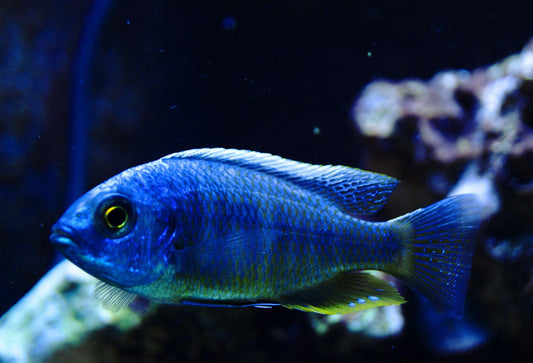Haplochromis:
Haplochromis are a species of african cichlids from Lake Malawi are commonly divided into three major groups: Utaka, Predatory “Haps” and Other “Haps”.
"Utaka Haps"
In Lake Malawi the Utaka Haplochromis species inhabit open water regions, but prefer to stay within a comparatively short distance from the cliffs. They form schools and feed on zooplankton.
Utaka cichlids are popular as aquarium species, and the fish will form beautiful schools if you keep many female Utaka cichlids together. Utaka cichlids are relatively peaceful and can be successfully kept in aquariums with Mbuna cichlids, as long as you choose some of the more docile species and not the highly aggressive ones.
The aquarium should ideally be high, and have a large area of open water for them to swim around in.
Diet: They will accept dry prepared foods, but they will do much better if you also feed them small crustaceans such as Cyclops. A varied diet with sufficient amounts of nutrients is necessary if you want the Utaka cichlids do display their full colouration.
All Utaka Haplochromis are mouthbreeders, but their breeding habits vary a lot. Some Utaka cichlids are seasonal spawners, while others are capable of producing offspring year round. Some Utaka cichlids build nests at the sandy bottom; some spawn out in the open water and a third group prefers cliffs as spawning sites. A batch will typically include 30-80 eggs.
If they were seasonal spawners in Lake Malawi, they will probably stick to this breeding pattern even in captivity. If your Utaka cichlids were born in an aquarium, they will most likely spawn year round even if they belong to an annual species. A male Utaka cichlid with a seasonal breeding pattern will only defend a territory during the breeding period, and his striking breeding colouration will only show during this time.
"Predatory Haps"
Predatory Haplochromis are large and prey on other Malawi cichlids. In Lake Malawi the Predatory Haps are not confined to any particular biotope; they visit many different environments in their search for food. Examples of Malawi cichlids belonging to this group are species from the genera; Tyrannochromis, Naevochromis, Nimbochromis, Aristochromis, Dimidiochromis, Taenochromis, Champsochromis, Exochochromis, Hemitaeniochromis, Lichnochromis, Buccochromis and Stigmatochromis.
All the Predatory Haps are mouth brooders, and a batch will typically include 50-250 eggs. The number of eggs depends on the species, but also on the size of the female.
Predatory Haplochromis will need a large aquarium. Several female Predatory Haps will do well together, while two or several males will fight each other constantly and should not be kept in the same aquarium. They will often get along with Mbuna cichlids, as long as the aquarium has a lot of hiding places and natural borders that make it possible for the fish to stay out of each others sight. Smaller fish should never be kept with Predator Haps, since they will be eaten sooner or later.
Diet: High Quality Pellet and appreciate live fish/frozen meaty foods
"Other Haps"
The third group of Malawi Haplochromis is a very diverse group, since it includes all the Malawi Haps that do not fit into the two other groups (Utaka and Predatory Haps). The group is simply called “Other Haps”, and includes such genera as; Fossorochromis, Otopharynx, Cheilochromis, Tramitichromis, Chilotilapia, Protomelas, Cyrtocara, Taeniochromis, Mylochromis, Placidochromis, Hemitaeniochromis, Ctenopharynx, Hemitilapia and Sciaenochromis, Placidochromis. a
A large aquarium is necessary for most species. Use rocks to create hiding places. Avoid keeping more than one male in the aquarium, since males will fight a lot. Species from this group are all mouth brooders.
Diet: Prepared dry foods are acceptable, but it's best to complement this diet with foods that more closely resemble the natural diet of the specific species. Typically, one serving of dry food daily, supplemented with frozen food, is advisable. Care should be taken to prevent overfeeding, as it can cause males to lose their coloration.
https://www.sanctuarycichlids.com/products/nimbochromis-venustus
Source:
https://www.aquaticcommunity.com/cichlid/haplochromis.php



